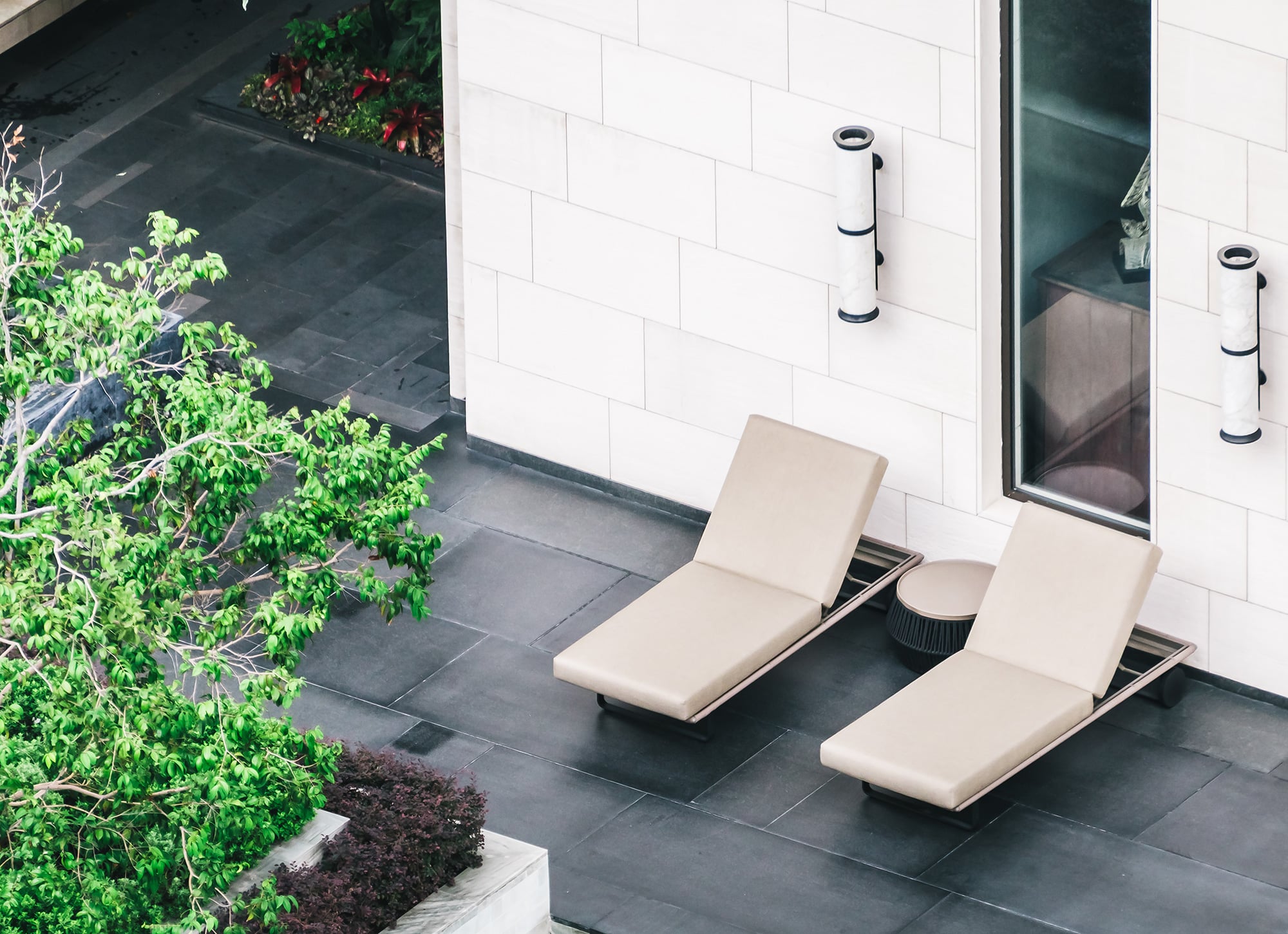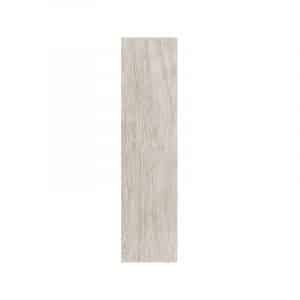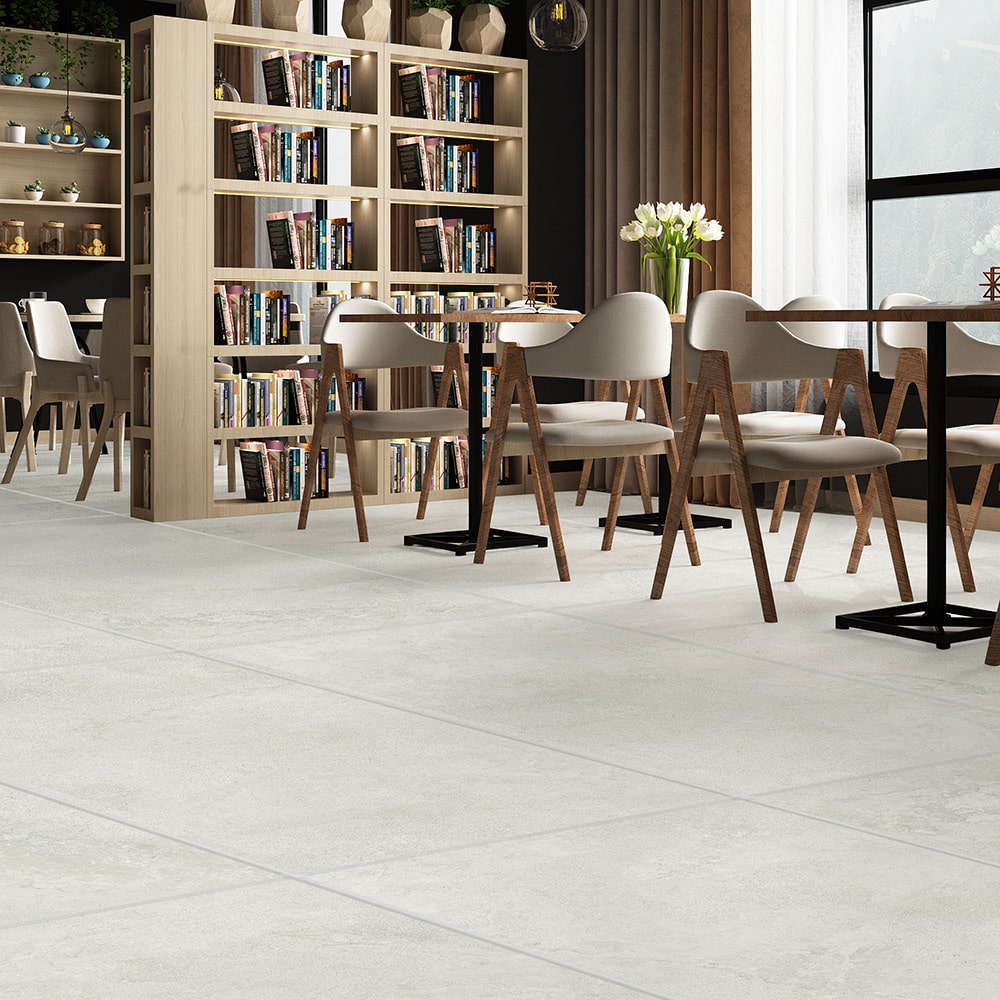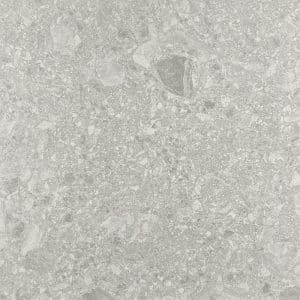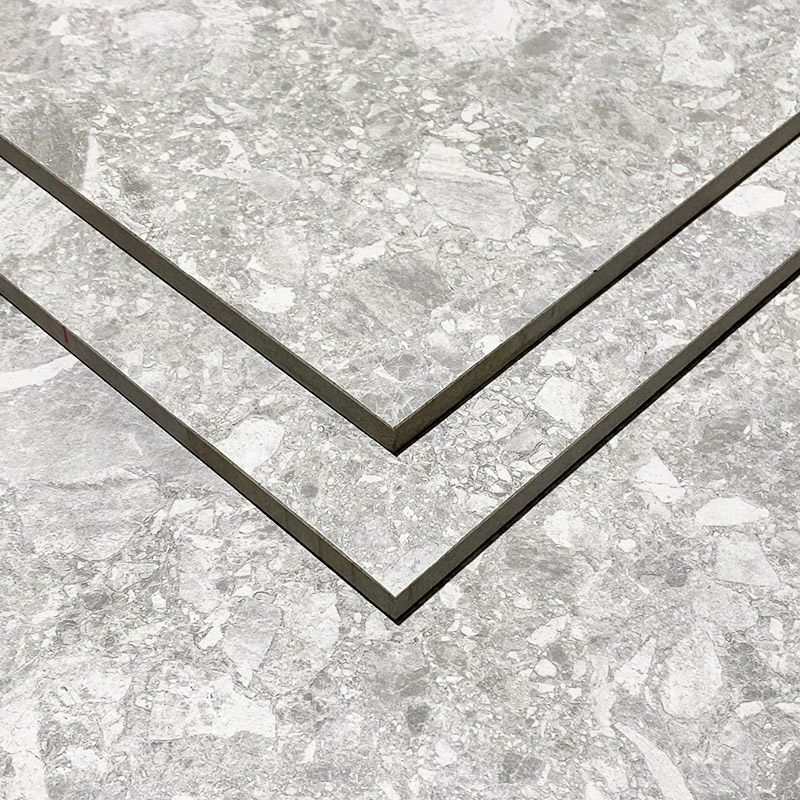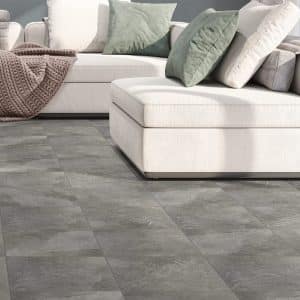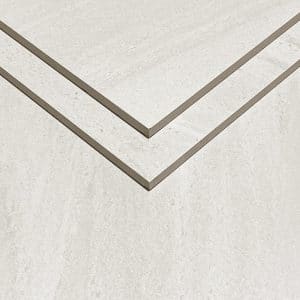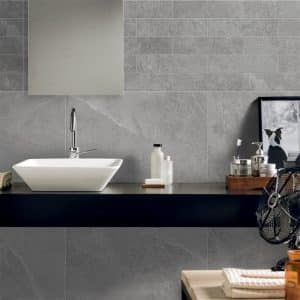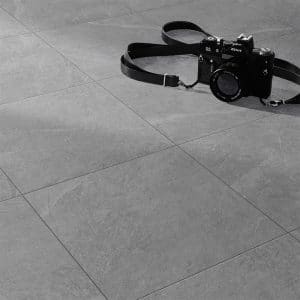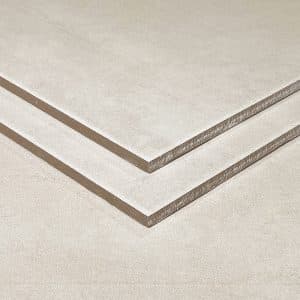How to Lay Outdoor Tiles?
Ever thought about how outdoor tiles could revolutionise your garden, patio, or balcony? Picture this: a chic, refreshed space that’s just perfect for hosting those summer barbecues or enjoying serene morning coffees. Sounds dreamy, right? But how do you get started on this transformation?
No need to fret, Cheap Tiles Online are here to help. In this blog post, we’ll walk you through the entire process, one step at a time. So, dear Aussie homeowners, let’s embark on this journey together to elevate your outdoor living spaces.
What Tools Do You Need to Lay Outdoor Tiles?
Before you begin, it’s important to gather all the necessary tools. Here’s what you’ll need:
- Notched Trowel: This is your best friend when it comes to spreading adhesive evenly. It’s got a serrated edge that creates those perfect lines of adhesive for your tiles to adhere to.
- Rubber Mallet: You’ll need this to gently tap your tiles into place. It’s all about getting that perfect alignment without damaging your beautiful new tiles.
- Tile Spacers: These little guys are crucial for maintaining even gaps between your tiles. They ensure your layout looks professional and polished.
- Spirit Level: This tool is essential to check the flatness and straightness of your tile arrangement. There’s nothing worse than a wonky tile!
- Tile Cutter: Whether you’re dealing with porcelain, ceramic or natural stone tiles, a tile cutter will help you trim your tiles to the perfect size.
- Safety Glasses: Protecting your eyes should be a top priority when cutting tiles. Those tiny fragments can be hazardous!
- Knee Pads: Trust us, your knees will thank you! Laying tiles involves a lot of kneeling, so keep them protected with some comfy knee pads.
- Grout Float: This tool helps you spread grout into the spaces between your tiles. It’s designed to press grout in firmly while removing excess from the surface.
- Bucket and Sponge: You’ll need these for cleaning up as you go along. A damp sponge does wonders at wiping away excess grout before it dries.
- Gloves: Last, but not least, a good pair of gloves will protect your hands from the rough materials and prevent any blisters from the tools.
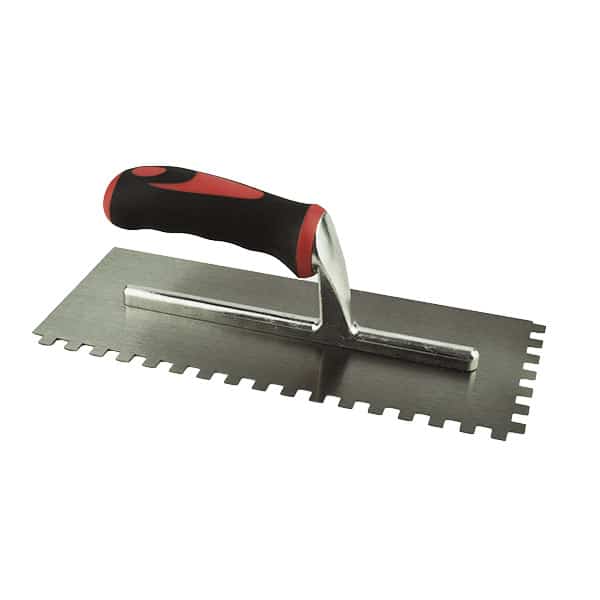
Bright Steel Adhesive Trowel with rubber handle – 8mm
$20.00 $15.00
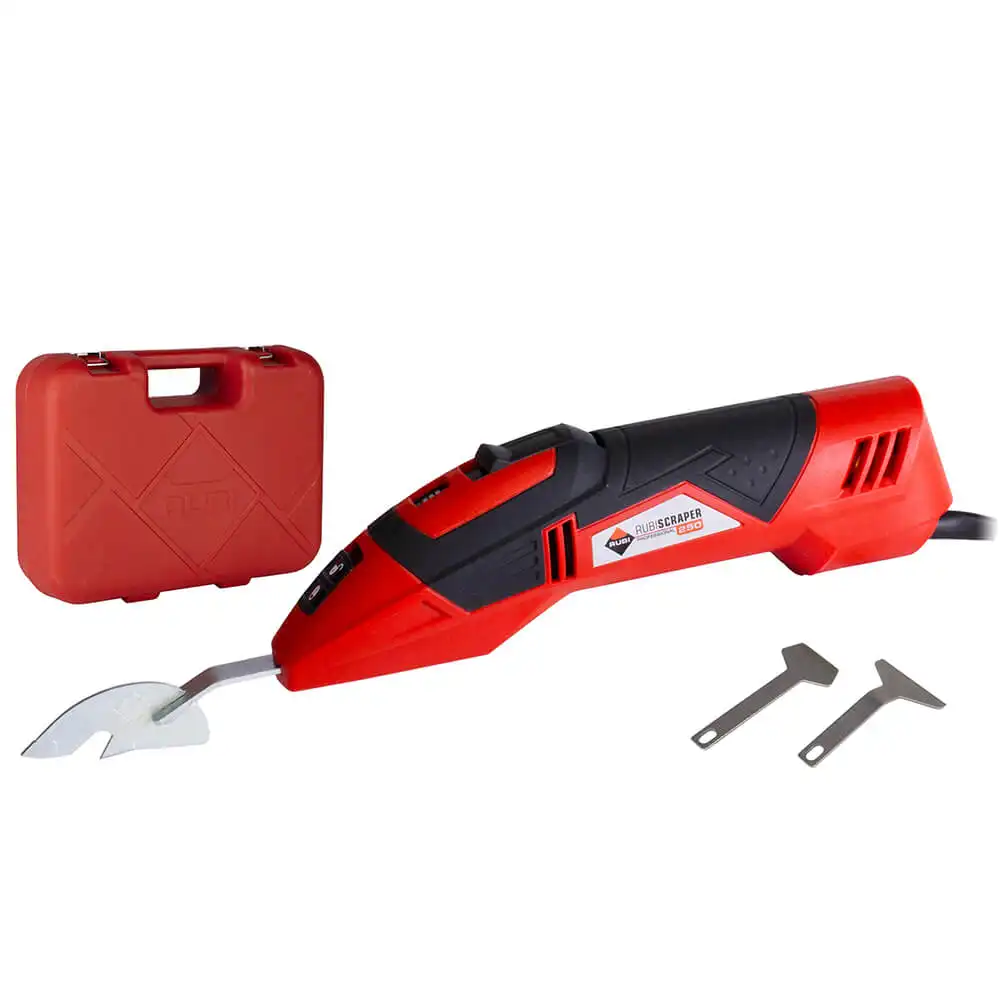
Rubi Electric Joint Scraper 250
$362.95 ea
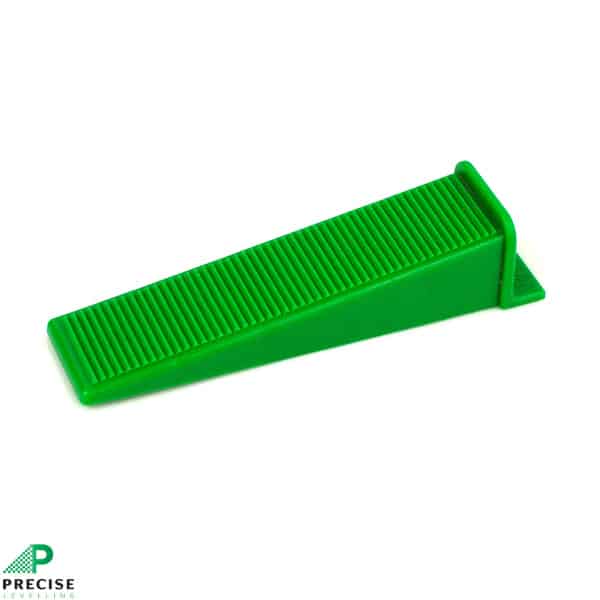
Precise Levelling System – Reusable Wedges (1800 Pack)(Free Shipping)
$290.00
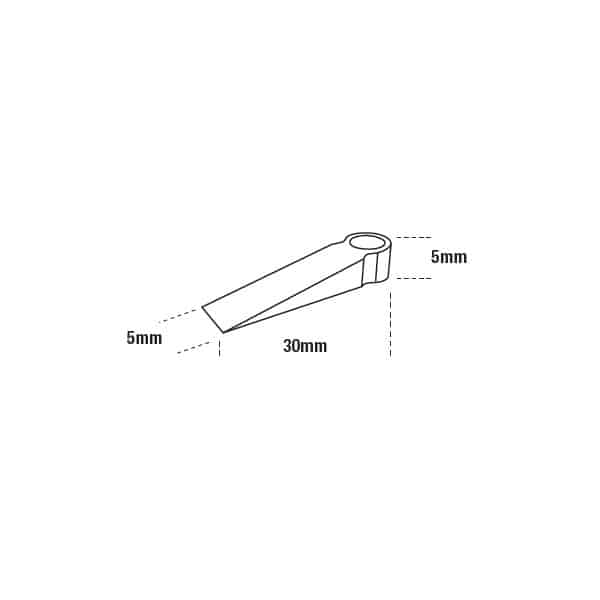
Tile Wedges 0.5 – 5mm gap x 100 pack
$6.00

iQ Power Tools Dry Diamond 250mm Soft Material Blade
$296.95 ea

Lauxes Hole Saw 50mm
$45.00 ea
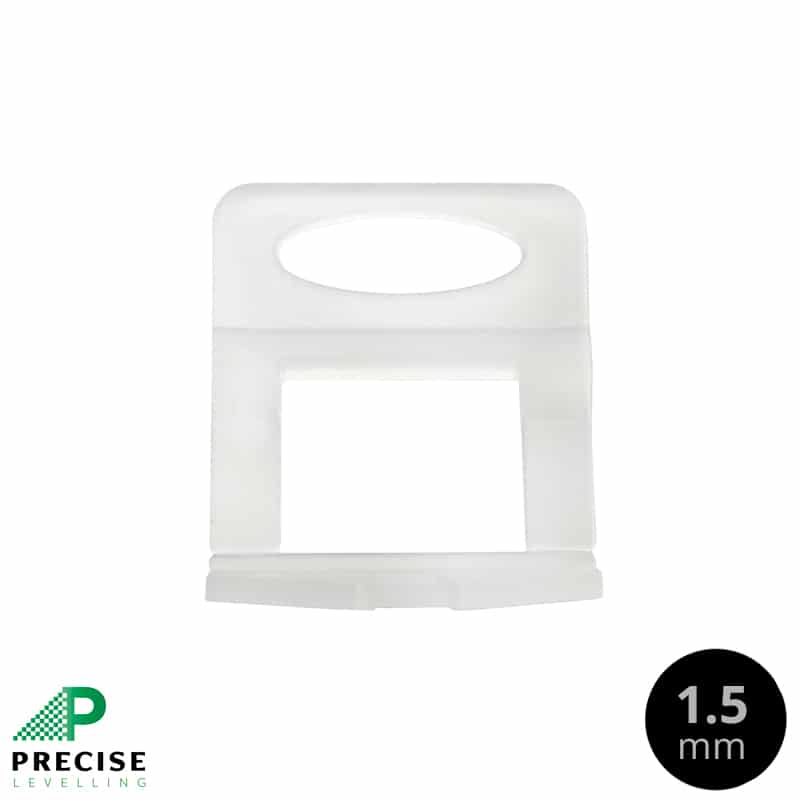
Precise Levelling System – Spacer 1.5mm 500 pack
$50.00
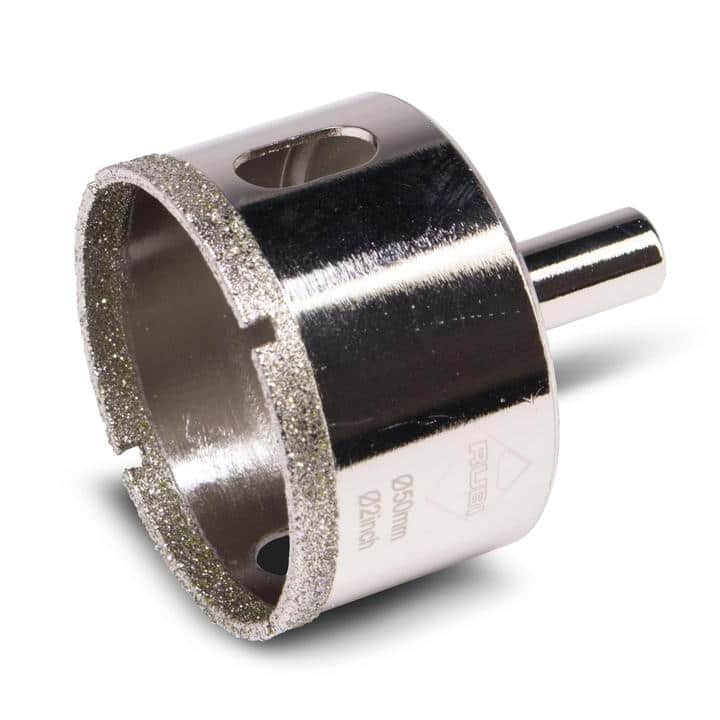
Rubi Easy-Gres (SRT) 50mm Wet Drill Bit
$55.95 ea
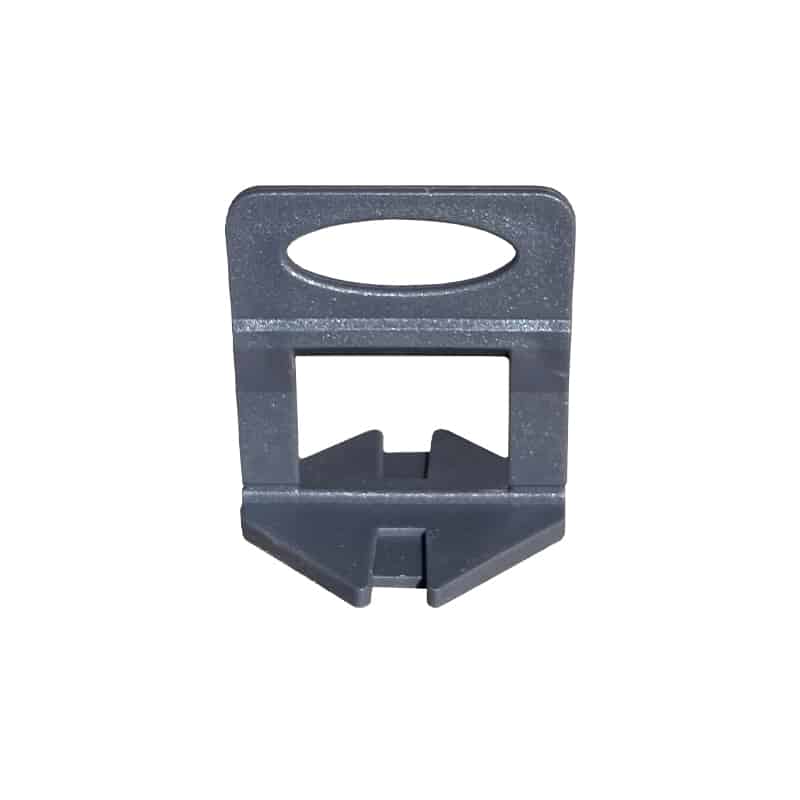
Switch Clip – Spacer 1.5mm 250 pack
$20.00
Which Tile Type is Best for Outdoors?
The tile you select will mostly depend on the aesthetic you desire, but certain types are particularly well-suited for outdoor use.
Porcelain Tiles
An outdoor porcelain tile should be your first consideration when it comes to choosing outdoor tiles. Why, you ask? When you lay porcelain tiles, you get a highly durable and frost-resistant surface that is low maintenance and looks amazing. Only a simple sweep and occasional wash will keep them looking pristine.
Slate Tiles
If you’re a fan of the rustic appeal, slate tiles might just win your heart. They offer natural slip resistance, an ideal feature if your outdoor space includes a pool or hot tub. An added advantage? Their dark tones do a great job of camouflaging dirt!
Quarry Tiles
These unglazed tiles serve as another excellent choice to lay in your outdoor areas. Quarry tiles undergo high-temperature firings, which make them naturally dense and water-resistant. If your style leans towards the traditional, these tiles could be your perfect mate.
Granite Tiles
When durability tops your list of priorities, turn your attention to granite. This extremely hard material stands up to wear and tear like a pro. Available in a spectrum of colours, granite tiles lend an elegant touch to any outdoor space.
Travertine Tiles
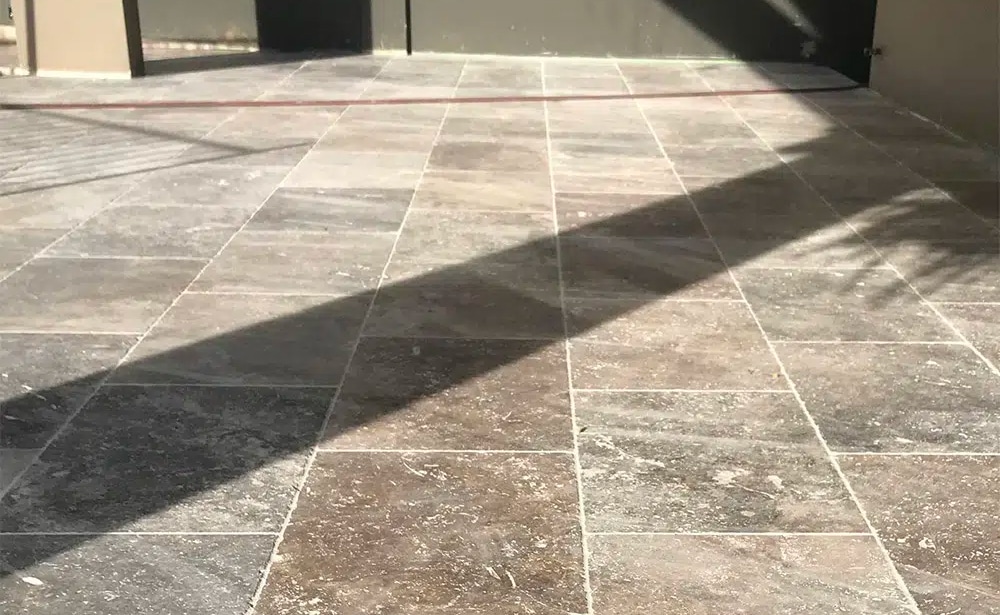 For a taste of luxury, consider travertine. A variety of limestone, it offers a unique, earthy charm. However, remember that travertine requires consistent sealing to shield it from stains and weather damage.
For a taste of luxury, consider travertine. A variety of limestone, it offers a unique, earthy charm. However, remember that travertine requires consistent sealing to shield it from stains and weather damage.
Concrete Tiles
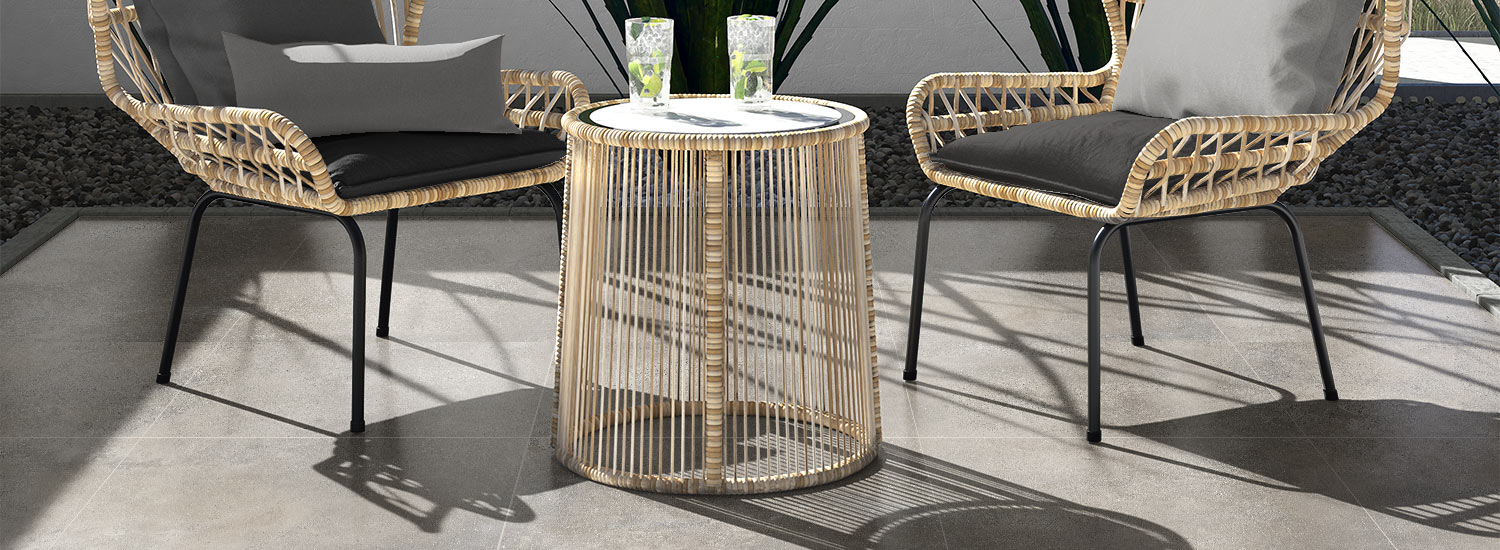 Last on our list, but certainly not least, we have concrete tiles. These tiles provide a contemporary, industrial vibe and can be customised in numerous ways. Concrete is as tough as they come, capable of enduring heavy foot traffic and severe weather conditions.
Last on our list, but certainly not least, we have concrete tiles. These tiles provide a contemporary, industrial vibe and can be customised in numerous ways. Concrete is as tough as they come, capable of enduring heavy foot traffic and severe weather conditions.
Whether you’re looking to install outdoor tile on a patio, a concrete slab, or porcelain pavers, this guide should help you choose the right one for your project.
How to Lay Outdoor Floor Tiles
So, you’ve chosen your perfect outdoor patio tiles and gathered all your tools. Now comes the fun part – laying your outdoor floor tiles! Don’t fret, we’re here to walk you through every step of the process. Let’s roll up our sleeves and get started!
Step #1: Prepping the Area
The first order of business is to prepare your surface. This involves a thorough cleaning to eliminate any dirt or debris. You can use a pressure washer or a simple garden hose to get rid of any dirt and grime.
If your surface isn’t level, you’ll need to rectify this before installing tiles. Why? A level surface is crucial for ensuring your tiles lay flat and secure. And don’t overlook the application of a waterproofing membrane for added protection against moisture.
Step #2: Plotting Your Course
Now, it’s time to plan your layout. Initiate from the centre of your outdoor area and gradually work your way out. This approach aids in evenly distributing full and cut tiles throughout your space. Remember, this step calls for patience and precision.
Step #3: Laying the Tiles
The moment has arrived to lay the tiles. With your notched trowel, smear tile adhesive or mortar bed onto the surface. Then, position your first tile onto the adhesive, gently pressing down to ensure it adheres.
Make sure there’s a slight slope away from your house for proper drainage and to avoid water pooling. Utilise your rubber mallet to tap it snugly into place. Don’t forget to arrange tile spacers around each tile to maintain uniform gaps.
Step #4: Trimming and Fitting
There will likely be instances where you’ll need to adjust some tiles to fit the boundaries of your area. The key here is to measure twice and cut once.
After carefully measuring and marking your tiles, trim them to the necessary size. This could involve cutting a straight edge or shaping the tile to fit around obstacles.
Once you’ve made these adjustments, lay these tiles just as you did with the full-sized ones, ensuring they rest on a stable gravel layer if required.
Step #5: Applying Grout
Hold off until the adhesive is fully dry before moving on to this step. Once set, remove the tile spacers and begin applying grout into the gaps between your tiles. Use a grout float to press the grout firmly into the spaces, scraping away any excess as you proceed.
Step #6: Final Cleanup
Lastly, clean your freshly laid tiles with a damp sponge, wiping off any lingering grout residue. Once the grout has dried, give your tiles another clean to reveal their true beauty.
Step #7: Applying Grout Sealer
While this step is optional, applying a grout sealer is a smart move. It helps safeguard your grout from dirt and moisture, preserving its pristine appearance for years to come. Simply apply the sealer with a small brush, and you’re done.
How to Install Outdoor Wall Tiles
Now, you’ve decided to upgrade your outdoor space with some stylish wall tiles. Excellent choice! Installing outdoor wall tiles can be a rewarding DIY project, and we’re here to guide you through the process step by step.
Step #1: Preparation
Just like with floor tiles, the first step is preparing your surface. Clean your wall thoroughly to remove any dirt or debris. If there are any cracks or holes, fill them in with a suitable filler.
Step #2: Planning
Next, it’s time to plan your layout. Starting from the centre of your wall and working your way out ensures an even distribution of full and cut tiles. Use a chalk line or laser level to mark your starting point and keep your rows straight.
Step #3: Applying Adhesive
Now, apply tile adhesive onto the wall using your notched trowel. The notches create ridges in the adhesive, which helps the tiles adhere better. Remember, only apply as much adhesive as you can and cover it with tiles before it starts to dry. A mix of sharp sand and cement usually works well as an adhesive for outdoor tiles.
Step #4: Setting the Tiles
Start setting your tiles onto the adhesive. Press each tile firmly into place and give it a little wiggle to ensure a good bond. Use tile spacers to maintain consistent gaps for grout.
Step #5: Cutting Tiles
You’ll likely need to cut some tiles to fit around edges, corners, or fixtures. Measure twice and cut once with your tile cutter. Then, apply these tiles just as you did with the full-size ones.
Step #6: Grouting
Once the adhesive has dried completely (usually after 24 hours), remove the tile spacers and start grouting. Use your grout float to press the grout into the gaps and scrape off the excess.
Step #7: Cleaning
 Finally, clean your newly installed tiles with a damp sponge, removing any leftover grout on the tile surfaces. Once the grout has dried, give your tiles another good clean to reveal their true shine.
Finally, clean your newly installed tiles with a damp sponge, removing any leftover grout on the tile surfaces. Once the grout has dried, give your tiles another good clean to reveal their true shine.
Step #8: Sealing Your Grout
As the final step in your installation process, it’s a good idea to apply a top-notch grout sealer. Using a brush, make sure to spread the sealer evenly across all the grouted areas. This vital action will shield your grout from dirt and mould, ensuring they hold onto its stunning appearance for many, many years ahead.
Key Safety Considerations for Installing Outdoor Tiles
When it comes to installing outdoor tiles, safety should always be your co-pilot. A DIY project isn’t just about the final result but also about how safely you got there. To help you out, here are crucial safety tips to keep in mind.
1. Wear Protective Gear
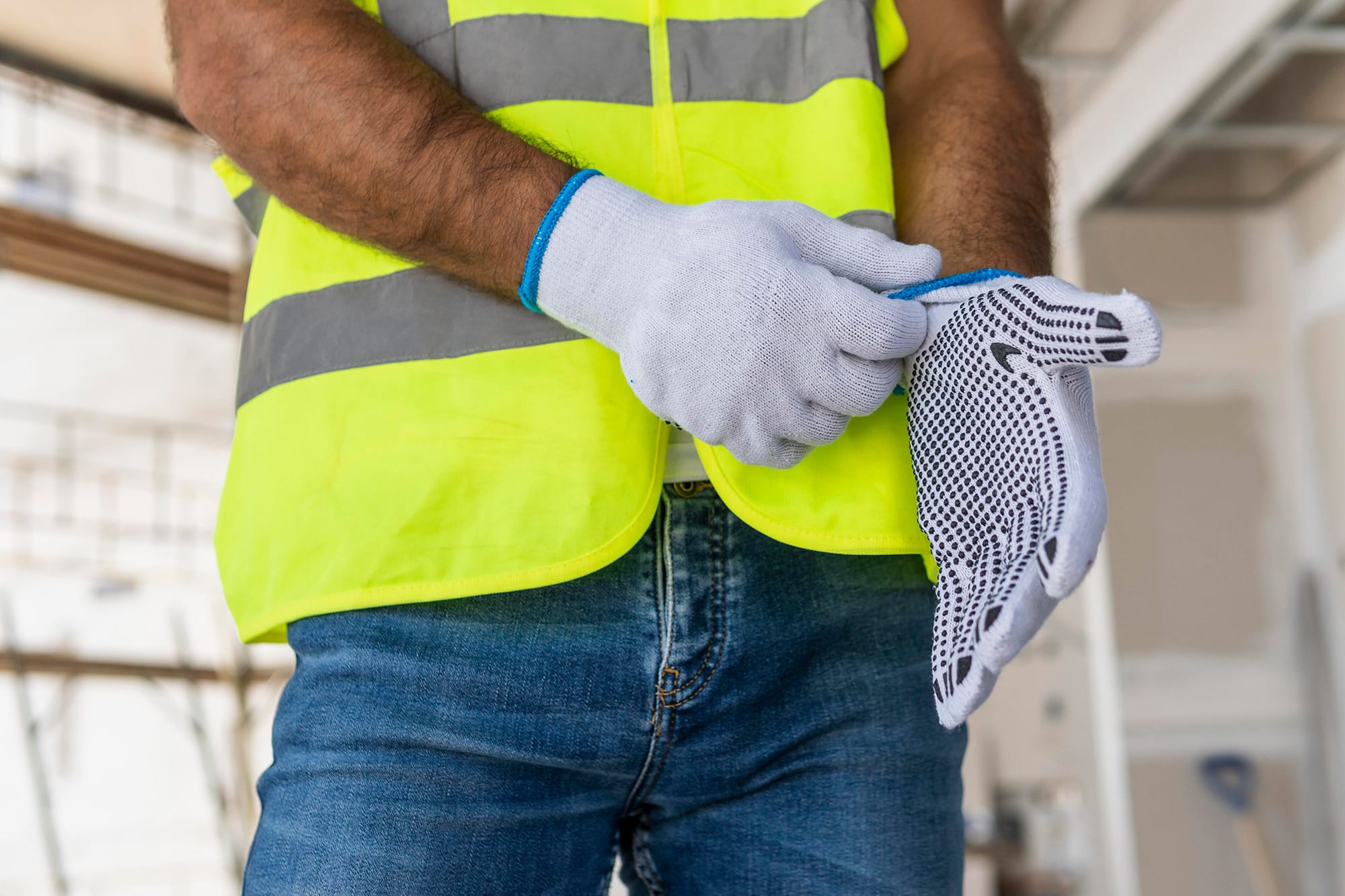 Never underestimate the importance of proper protective gear. Safety glasses can protect your eyes from flying fragments when cutting tiles. Gloves help to shield your hands from sharp tile edges and potentially irritating substances like adhesive and grout.
Never underestimate the importance of proper protective gear. Safety glasses can protect your eyes from flying fragments when cutting tiles. Gloves help to shield your hands from sharp tile edges and potentially irritating substances like adhesive and grout.
And don’t forget about sturdy, closed-toe footwear – it can protect your feet from falling tiles and provide a better grip on potentially slippery surfaces.
2. Use Tools Correctly
Just like every person has a unique story, each tool has its own special purpose and way of operating. So, before you channel your inner ‘DIY guru’ for your tiling project, ensure you’ve gone through the manufacturer’s instructions for each tool you’ll be using.
Power tools such as tile cutters are there to be your reliable allies, streamlining your project and making it more efficient. They’re not meant to add unnecessary suspense to your DIY journey. So, handle them with care and always prioritise safety.
3. Check Your Surroundings
A cluttered workspace is a hazard waiting to happen. Keep your area clean and organised, stowing tools and materials away when not in use. Ensure cables are safely tucked away to prevent tripping.
Good lighting is also crucial – it helps you see what you’re doing clearly, reducing the chance of mistakes or accidents.
4. Handle Tiles Carefully
Tiles can be surprisingly heavy, putting strain on your back and arms if not handled properly. Always bend at your knees when lifting heavy tiles. The edges of cut tiles can be very sharp, so handle them with care to avoid cuts.
If a tile feels too heavy, don’t hesitate to ask for help – it’s better to be safe than sorry.
5. Proper Ventilation
Even though you’re working outdoors, certain adhesives and sealants can release strong fumes. Make sure you’re in a well-ventilated area when using these products, and consider wearing a mask for additional protection.
6. Choose Slip-resistant Tiles
Outdoor tiles often get wet due to rain, dew, or pool water, which can make them dangerously slippery. When selecting your tiles, opt for ones with a slip-resistant surface to reduce the likelihood of slips and falls.
7. Take Regular Breaks
Remember, this task demands your full attention, a keen eye for detail, and a fair bit of elbow grease. So don’t shy away from taking regular breaks. Think of them as pit stops that rejuvenate your energy, sharpen your focus, and ensure your work remains top-notch.
Final Thoughts
Laying outdoor tiles can be a gratifying DIY project, enhancing the beauty and worth of your home. The secret ingredient? Patience, preparation, and a healthy dose of safety consciousness. Remember, good things take time.
We hope you’ve found this guide helpful and inspiring. And when you’re ready to start your own tiling adventure, remember that Cheap Tiles Online is here for you. We offer a wide range of high-quality tiles perfect for both indoor and outdoor living spaces, designed to complement every Aussie home out there.
So why wait? Let’s create something beautiful together. Happy tiling, mates!

